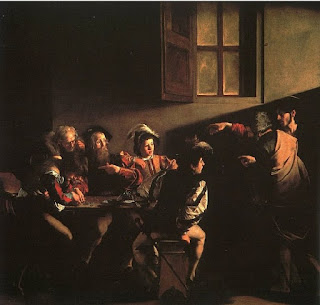Powers of Observation
It's raining out and though my daughter is on the mend (hurray!), she's still very weak, so we're not going anywhere today. I'm hoping that I'll get to spend a little time in my studio. But before I go, I thought I'd share info on two art-related articles in the October 2009 issue of Smithsonian magazine that I read yesterday. The first one, called "Teaching Cops to See" (by Neal Hirschfield) gave an overview of a program being used in New York City. In a nutshell, an art historian and lawyer named Amy Herman uses art to help police officers develop their observation skills. Using a variety of of artwork and exercises, participants fine tune their ability to note and describe scenes and people. In turn, this improves their chances of giving accurate descriptions of suspects and crime scenes. Officers are forbidden to use the words "obviously" and "clearly", eliminating preconceived notions. The artwork is presented without the title as well, so the officers aren't "led" into thinking one way or another. They have to develop their own ideas about about what's going on in the scene on canvas, just as they would in real life. I think it's pretty fascinating that art can be used in this way.

Carravaggio's painting, The Calling of St. Matthew, is just one of the paintings used in the program.
The second article had to do with Leonardo da Vinci. There is a beautiful altar panel in Florence, Italy called Beheading of St. John the Baptist. Andrea del Verrocchio was commissioned to create the panel. Now, an eminent Leonardo scholar named Gary M. Radke is positing that two of the figures on the panel may have been created by Leonardo da Vinci when he was a student of Verrocchio's. First, I was fascinated even to consider that Leonardo was ever a student. (Yes, that clearly shows my ignorance.) Apparently, Leonardo was an apprentice for at least a decade. Second, I was intrigued by how little we know of the Renaissance artists because they left few markings noting who worked on what. In this case, history, sketches, sculptural details and even the back side of the sculpture were all data points that Radke considered in making his proposition. For example, the clothes on two of the figures were rendered with more natural movement than in other figures on the panel. Even the back of the two figures in question -- which were attached to the panel -- had more realistic details. This was more in keeping with Leonardo's style. In addition, the face of one of the figures was similar to a sketch Leonardo made during the same time period that the panel was worked on. It's all a bit of detective work -- all about observing art. I think it's pretty cool.
Here's a detail of the panel. The figures the Radke thinks might have been made by Leonardo are the second from the right and the far left.


Carravaggio's painting, The Calling of St. Matthew, is just one of the paintings used in the program.
The second article had to do with Leonardo da Vinci. There is a beautiful altar panel in Florence, Italy called Beheading of St. John the Baptist. Andrea del Verrocchio was commissioned to create the panel. Now, an eminent Leonardo scholar named Gary M. Radke is positing that two of the figures on the panel may have been created by Leonardo da Vinci when he was a student of Verrocchio's. First, I was fascinated even to consider that Leonardo was ever a student. (Yes, that clearly shows my ignorance.) Apparently, Leonardo was an apprentice for at least a decade. Second, I was intrigued by how little we know of the Renaissance artists because they left few markings noting who worked on what. In this case, history, sketches, sculptural details and even the back side of the sculpture were all data points that Radke considered in making his proposition. For example, the clothes on two of the figures were rendered with more natural movement than in other figures on the panel. Even the back of the two figures in question -- which were attached to the panel -- had more realistic details. This was more in keeping with Leonardo's style. In addition, the face of one of the figures was similar to a sketch Leonardo made during the same time period that the panel was worked on. It's all a bit of detective work -- all about observing art. I think it's pretty cool.
Here's a detail of the panel. The figures the Radke thinks might have been made by Leonardo are the second from the right and the far left.

Comments
hope you got into the studio!